
Sri Lankan cuisine is known for its particular combinations of herbs, spices, fish, vegetables, rices, and fruits. The cuisine is highly centered around many varieties of rice, as well as coconut which is a ubiquitous plant throughout the country. Seafood also plays a significant role in the cuisine, be it fresh fish or preserved fish. As a country that was a hub in the historic oceanic silk road, contact with foreign traders brought new food items and cultural influences in addition to the local traditions of the country's ethnic groups, all of which have helped shape Sri Lankan cuisine. Influences from Indian, Indonesian and Dutch cuisines are most evident with Sri Lankan cuisine sharing close ties to other neighbouring South and Southeast Asian cuisines.

Tamil cuisine is a culinary style originating in the southern Indian state of Tamil Nadu and other countries of South Asia like Sri Lanka. Meats, along with rice, legumes, and lentils, are also popular. Dairy products and tamarind are used to provide sour flavors. On special occasions, traditional Tamil dishes are served in a traditional manner, using banana leaves in place of utensils. After eating, the banana leaves are then used as a secondary food for cattle. A typical breakfast meal consists of idli or dosa with chutney. Lunch includes Rice, sambar, curd, kuzhambu, and rasam.

Ugali or posho or sima is a type of maize swallow made from maize or corn flour in several countries in Africa. Sima is sometimes made from other flours, such as millet or sorghum flour, and is sometimes mixed with cassava flour. It is cooked in boiling water or milk until it reaches a stiff or firm dough-like consistency. In 2017, the dish was added to the UNESCO Representative List of the Intangible Cultural Heritage of Humanity, one of a few foods in the list.
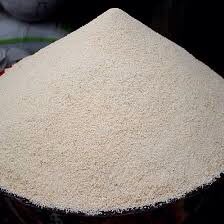
In West Africa, garri is the flour of the fresh starchy cassava root.

Chili sauce and chili paste are condiments prepared with chili peppers.

Jollof, or jollofrice, is a rice dish from West Africa. The dish is typically made with long-grain rice, tomatoes, onions, spices, vegetables and meat in a single pot, although its ingredients and preparation methods vary across different regions.

Ghanaian cuisine is the cuisine of the Ghanaian people. Ghanaian main dishes are organized around a starchy staple food, which goes with a sauce or soup containing a protein source. The main ingredients for the vast majority of soups and stews are tomatoes, hot peppers and onions. As a result, most of the Ghanaian soups and stews are red or orange in appearance.

Àkàrà (Yoruba)(English: Bean cake Hausa: kosai, Portuguese: Acarajé is a type of fritter made from cowpeas or beans from Nigeria. It is found throughout West African, Caribbean, and Brazilian cuisines. The dish is traditionally encountered in Brazil's northeastern state of Bahia, especially in the city of Salvador. Acarajé serves as both a religious offering to the gods in the Candomblé religion and as street food. The dish was brought by enslaved peoples from West Africa, and can still be found in various forms in Nigeria, Ghana, Togo, Benin, Mali, Gambia, Burkina Faso and Sierra Leone.

Fried plantain is a dish cooked wherever plantains grow, from West Africa to East Africa as well as Central America, the tropical region of northern South America and the Caribbean countries like Haiti to Cuba and in many parts of Southeast Asia, where fried snacks are widely popular. In Indonesia it is called gorengan. It is called alloco in Côte d'Ivoire and dodo in Western Nigeria, otherwise known as simply fried plantain in other parts of Nigeria. Kelewele is a fried spicy plantain or can be fried as a side dish for Red Red and fish stew in Ghana.

West African cuisine encompasses a diverse range of foods that are split between its 16 countries. In West Africa, many families grow and raise their own food, and within each there is a division of labor. Indigenous foods consist of a number of plant species and animals, and are important to those whose lifestyle depends on farming and hunting.

Nigerian cuisine consists of dishes or food items from the hundreds of ethnic groups that comprise Nigeria. Like other West African cuisines, it uses spices and herbs with palm or groundnut oil to create deeply flavored sauces and soups.
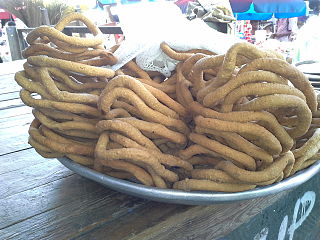
Kuli-kuli is a West African snack primarily made from peanuts. First made by the Nupe People of West Africa it is a popular snack in Nigeria, Benin, northern Cameroon and Ghana. It is often eaten alone or with a mixture of garri also known as cassava flakes, sugar and water, popularly called "garri soakings". It is also eaten with Hausa koko, fura, kamu; and is sometimes ground and put into salad. It is often ground as used as an ingredient for Suya and Kilishi.
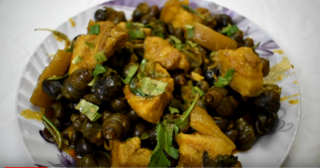
Manipuri cuisine refers to the cuisine of Manipur, a state of northeastern India. Daily meals are based on rice, with a few side dishes of vegetables, fish and meat. A meal would usually have a vegetable stew called ensaang or athongba, flavored with dried or fried fish; stir-fried vegetables called kanghou; and a spicy item, which could be morok metpa, iromba, or singju. All piquant side dishes are accompanied by a choice of fresh herbs, collectively called maroi. The base and essence of Meitei cuisine is the fermented fish called ngari. Several dishes of meat, mostly chicken and pork, are cooked with unique recipes. As a result of religious taboos, however, the Meitei Pangals do not cook the latter.
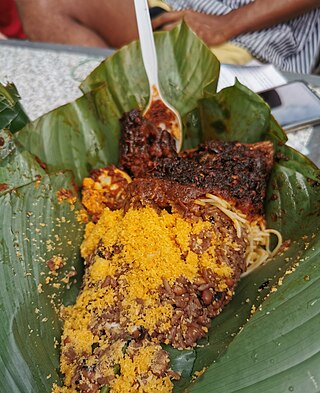
Waakye is a Ghanaian dish of cooked rice and beans, commonly eaten for breakfast or lunch. However, others eat it for supper. The rice and beans, usually black eyed peas or cow beans, are cooked together, along with red dried sorghum leaf sheaths or stalks and limestone. The sorghum leaves and limestone give the dish its characteristic flavor and a red appearance and the sorghum is taken out before consumption. The word waakye is from the Nigerian Hausa language and means beans. It is the contracted form of the full name shinkafa da wake which means rice and beans.
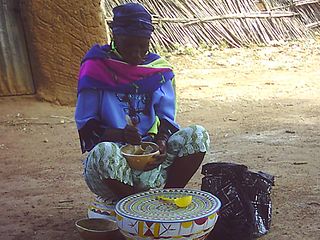
Fura or doonu is a type of food originating from West Africa’s Sahel region and that is popular among the Zarma-Songhai, Fulani and Hausa peoples of the Sahel. It is a millet dough ball, with "fura" meaning millet ball. It is also eaten in Niger and Ghana. Certainly, the making of the classic dish, fura da nono, represents such a blending of food resources and styles of cuisine. This suggests that a transfer of the cuisine of fura served with sour ... The millet is grounded into a powdered form, rolled and molded into balls, then mashed and mixed with Nono - a fermented milk. The combination of fura and nono is known as Fura Da Nono, a locally-made drink that contains carbohydrate and fiber. The fura food and the fura da nono drink are popular in Northern Nigeria. They are served during special occasions and as a meal in the afternoons.

Kyinkyinga or Cincinga, is a grilled meat skewer or kebab that is common and popular in West Africa and is related to the Suya kebab. Kyinkyinga is a Ghanaian Hausa dish popularised by traders in the Zango areas of town and cities, and has since becoming popular among other Ghanaians. It is hence very similar to or synonymous with the suya kebab in Nigeria and Niger, also known as suya, tsinga, cinga, cicinga, cincinga, tsire agashi, cacanga or tankora in the Hausa language.

Wasawasa is a popular dish, eaten in Dagbon and other parts of Northern Ghana. It is also eaten in some West African countries, such as Burkina Faso. It is made from dried yam peelings called jaling, which have been grounded into flour and steamed. Wasawasa is mostly eaten with spicy sauces and sometimes garnished with vegetables, accompanied with shea butter or raw groundnut oil and fried fish. Wasawasa is sometimes served with beans, pasta, and salad.
Hausa cuisines are traditional and modern food prepared by Hausa people. It is based on the availability of raw food materials they can farm or provide from other places. Most times Hausa people depend purely on the farm products they have cultivated for food preparations. Hausa people have a meal that is common to most Zongo communities called Tuo Zaafi.

Koose is a spicy black-eyed pea fritter that is commonly eaten in West Africa as a snack.



















